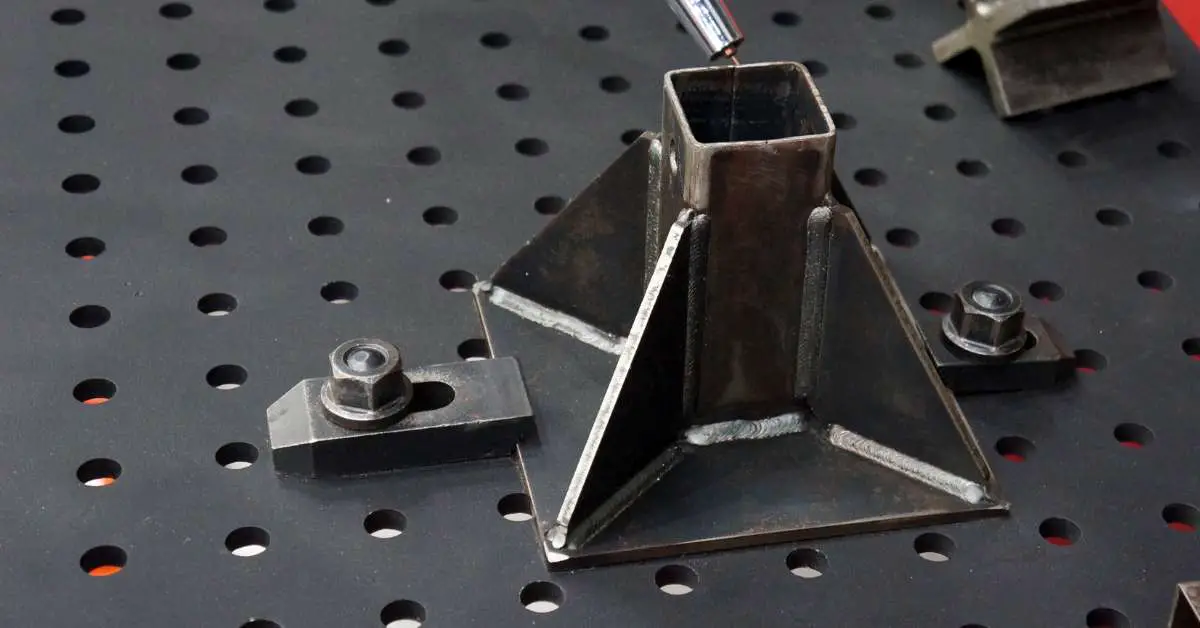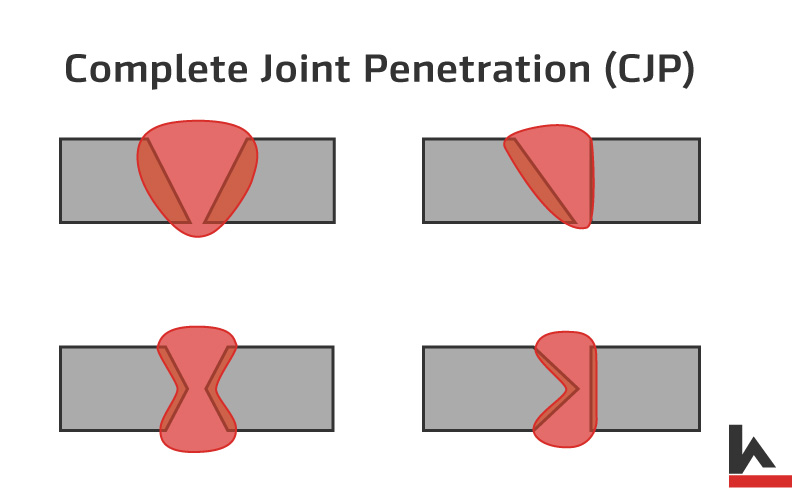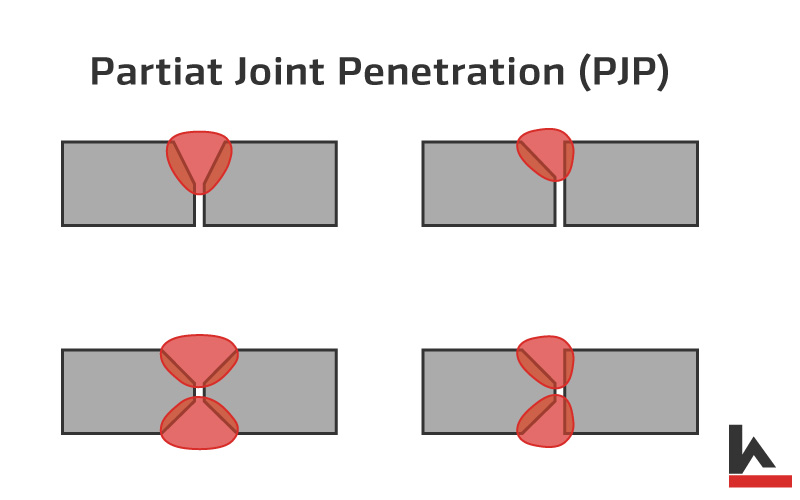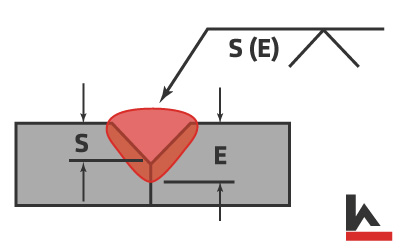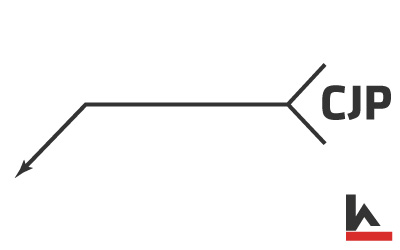Complete joint penetration (CJP) welds and partial joint penetration (PJP) welds are two types of groove welds. The main difference is the amount of penetration achieved during the welding process.
CJP welds offer complete fusion through the entire thickness of the joint, while PJP welds only penetrate a portion of the joint. CJP welds are typically stronger and more dependable than PJP welds because they provide full joint penetration and better fusion between the base and weld metal.
So, whether you’re a professional welder or starting out, keep reading to learn more about CJP vs. PJP.
What is Complete Joint Penetration Weld?
Complete Joint Penetration (CJP) welding is a groove weld typically used in heavy-duty structural welding and fabrication.
CJP welds offer the highest strength and dependability because they penetrate the entire thickness of the base material. CJP welds are used in various joint configurations, including butt joints, T joints, and corner joints.
The advantages of CJP welding include superior weld strength, high dependability, and improved fatigue resistance. CJP welds also have a neater appearance than partial joint penetration (PJP) welds, as there are no visible gaps or voids.
However, CJP welding requires more time, expertise, and equipment, making it more expensive than other weld types. Additionally, it may not be suitable for thinner materials or low-stress applications.
A prequalified welding procedure is required for CJP welds as per the American Welding Society “AWS D1.1 Structural Welding Code“. The weld may either be made from one side with steel backing or from both sides with back gouging.
What is Partial Joint Penetration Weld?
Partial joint penetration (PJP) welding is a type of weld where the welding filler material partially penetrates the base metal, leaving a gap between the base metal and the root of the weld.
PJP is commonly used in welding thinner materials, where full penetration is not required, or when welding is done on a double-sided or lap joint. Several types of joints can be welded using PJP, including butt, lap, and T joints.
The advantages of PJP welding include reduced material usage, less welding time, and less heat input, which can reduce distortion and cracking, especially in thin materials.
However, PJP does have its disadvantages. The weld metal does not penetrate fully, leaving the joint weaker than a fully-welded joint. Additionally, PJP welding may not be suitable for use in applications that require high stress or for materials that will be subjected to cyclic loading.
CJP Weld Vs PJP Weld
CJP weld and PJP weld are two types of welding techniques that differ in how they achieve joint penetration and use filler material.
CJP welds involve joint penetration, where the weld metal and base metal fuse together fully, creating a strong and reliable joint. In contrast, PJP welds only achieve partial joint penetration, meaning that the weld metal does not fully fuse with the base metal.
When it comes to filler material, CJP welds typically use more filler material than PJP welds because they require deeper penetration to achieve complete fusion between the metal pieces. Conversely, PJP welds use less filler material, which can result in cost savings and reduced welding time.
Both types of welds have their advantages and disadvantages. CJP welds are stronger, improved fatigue resistance and are more reliable than PJP welds, and they are suitable for high-stress applications.
However, CJP welds are more challenging to implement, have higher costs, and require skilled welders and specific welding equipment to achieve the desired penetration level.
On the other hand, PJP welds are easier to implement, faster and cost-effective and a popular choice for construction and automotive manufacturing.
The disadvantages of PJP welds include lower strength, reduced fatigue resistance, and insufficient penetration for thicker material applications. PJP may only be suitable for some applications due to their lower strength and dependability.
| Weld Type | Strength | Skill Required | Cost/Time Efficiency |
| Complete Joint Penetration | Superior due to full fusion between base/fused metal | More difficult in challenging positions such as overhead | More expensive/slower due to need for stronger filling materials/skill |
| Partial Joint Penetration | Lower due to gaps between joined pieces | Easier and less skill required overall | Less expensive/faster due to simplicity |
Techniques for Complete / Full Penetration Weld
Let’s explore some welding techniques to help you achieve strong and precise groove and fillet welds for complete joint penetration (CJP).
1. Welding Electrode: it’s essential to use the right electrode. The choice of electrode depends on the base metal being used, as well as the desired penetration and weld strength.
For CJP welding, electrodes with high penetrating power are recommended. Additionally, electrodes with a smaller diameter produce higher current density, which leads to deeper penetration.
2. Travel speed: Another important factor in achieving strong CJP welds is maintaining proper travel speed and torch angle. A slow travel speed or an improper torch angle can result in better fusion between the base and fused metals.
3. Heat Input: Maintaining consistent heat input throughout the arc welding process is crucial by adjusting parameters such as voltage and amperage based on the thickness of the materials being welded.
4. Backing Material: Steel backing is often used for single-sided welds, while back gouging may be necessary for double-sided welds. This ensures that full joint penetration is achieved without any gaps or voids in the welded area.
Remember that these are just starting points, and adjustments may need to be made based on factors such as electrode diameter, travel speed, and joint design. With practice and experience, you can hone your skills in CJP welding and produce strong, reliable joints for your projects.
Welding Techniques for Partial Joint Penetration
Partial joint penetration (PJP) welds are commonly used in many welding applications. Here are some welding techniques that can help you achieve strong and precise PJP welds:
1. Welding Electrode: For PJP welding, electrodes with moderate penetrating power are recommended. Additionally, electrodes with a larger diameter produce lower current density, which leads to shallower penetration.
2. Travel Speed: Maintaining proper travel speed and torch angle is crucial in achieving strong PJP welds. Too fast travel speed or an improper torch angle can result in insufficient penetration and poor fusion between the base and fused metals.
3. Heat Input: PJP welds do not require the same filling material as CJP welds and, therefore, can be completed with less heat input.
4. Edge Preparation: It is important to properly prepare the edges of the metal pieces being joined to achieve a successful PJP weld. Beveling or chamfering the edges can help ensure proper fusion between the base metal and filler material.
You can achieve strong and precise PJP welds for your projects by following these tips and techniques.
CJP and PJP Weld Symbol
Welding symbols are graphical representations that indicate the type of weld required for a particular joint. CJP and PJP welding have different symbols that indicate the type of weld required.
The weld size refers to the depth of preparation for the groove weld. The effective throat of a groove weld is the total thickness of material fused in the weld, including the depth of preparation and additional penetration.
In the above illustration, the effective weld throat (E) should appear in brackets on the right side of the depth of preparation (S) in the welding symbol. The value of (E) is measured from the top of the plate to the deepest point where the weld penetrates the joint.
Note: The absence of depth of preparation and the effective throat dimension indicates complete joint penetration.
Another symbol is as per the following illustration. The symbol indicates CJP in the arrow tail, which means a complete joint penetration groove weld regardless of the type of weld and joint preparation.
It is important to use the correct symbol to ensure that the weld is performed correctly and meets the application requirements.
Frequently Asked Questions
Can complete joint penetration welds be achieved without a backing material?
If you want to achieve complete joint penetration welds without a backing material, it’s possible but requires skill and proper technique. The edges of the metal must be beveled to assist in full penetration.
The welding parameters such as amperage, voltage, travel speed, electrode composition and diameter must be adjusted accordingly. Additionally, the technique used for welding, such as travel angle and speed, also impacts weld penetration.
How does the choice of welding position affect the strength and durability of the weld joint?
Welding position can significantly impact the strength and durability of the weld joint. The flat position is considered the easiest and most stable position for welding, while the overhead position requires more skill.
Ultimately, achieving a strong and durable weld joint requires proper technique and knowledge of how different variables can impact the outcome.
Are there any risks or downsides to using full joint penetration welds?
When it comes to complete joint penetration welds, there are some downsides and risks to consider. The excessive heat of CJP can disrupt the mechanical properties of the base metal, so it’s important to sacrifice a little penetration to enhance mechanical integrity in some situations.
Remember that each project brings unique challenges, so seeking advice from experienced welders and practicing is vital.
How do the electrode composition and diameter choice affect the joint’s weld penetration and overall strength?
Choosing the composition and diameter of your electrode can significantly affect the weld penetration and overall strength of the joint. Smaller electrodes produce higher current density, which can lead to deep penetration.
Some electrode grades are designed for better penetration, so choosing one that matches your specific welding needs is essential.
Conclusion
Understanding the differences between CJP welds and PJP welds is crucial for both professional welders and beginners. Each type of weld offers unique advantages and disadvantages.
CJP groove welds provide superior strength, dependability, and fatigue resistance. However, they require more skill, time, and equipment to execute. While PJP welds are faster, more cost-effective, and suitable for thinner materials, they may not be appropriate for high-stress applications due to their reduced strength and reliability.
By considering these factors, welders can make informed decisions that lead to successful and efficient welding processes.

